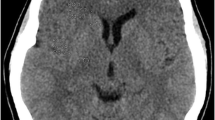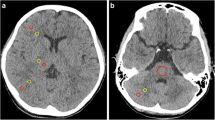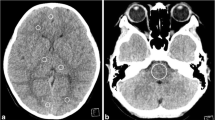Abstract
Posterior fossa artifacts constitute a characteristic limitation of cranial CT. To identify practical benefits and drawbacks of newer CT systems with reduced collimation in routine cranial imaging, we aimed to investigate image quality, posterior fossa artifacts and parenchymal delineation in non-enhanced CT (NECT) with 1-, 4-, 16- and 64-slice scanners using standard scan protocols. We prospectively enrolled 25 consecutive patients undergoing NECT on a 64-slice CT. Three groups with 25 patients having undergone NECT on 1-, 4- and 16-slice CT machines were matched regarding age and sex. Standard routine CT parameters were used on each CT system with helical acquisition in the posterior fossa; the parameters varied regarding collimation and radiation dose. Three blinded readers independently assessed the cases regarding image quality, infra- and supratentorial artifacts and delineation of brain parenchymal structures on a five-point ordinal scale. Reading orders were randomized. A proportional odds model that accounted for the correlated nature of the data was fit using generalized estimating equations. Posterior fossa artifacts were significantly reduced, and the delineation of infratentorial brain structures was significantly improved with the thinner collimation used for the newer CT systems (p<0.001). No significant differences were observed for midbrain structures (p>0.5). The thinner collimation available on modern CT systems leads to reduced posterior fossa artifacts and to a better delineation of brain parenchyma in the posterior fossa.




Similar content being viewed by others
References
Hu H, He HD, Foley WD, Fox SH (2000) Four multidetector-row helical CT: image quality and volume coverage speed. Radiology 215:55–62
Klingenbeck-Regn K, Schaller S, Flohr T, Ohnesorge B, Kopp AF, Baum U (1999) Subsecond multi-slice computed tomography: basics and applications. Eur J Radiol 31:110–124
McCollough CH, Zink FE (1999) Performance evaluation of a multi-slice CT system. Med Phys 26:2223–2230
Flohr TG, Stierstorfer K, Ulzheimer S, Bruder H, Primak AN, McCollough CH (2005) Image reconstruction and image quality evaluation for a 64-slice CT scanner with z-flying focal spot. Med Phys 32:2536–2547
Flohr T, Stierstorfer K, Raupach R, Ulzheimer S, Bruder H (2004) Performance evaluation of a 64-slice CT system with z-flying focal spot. Rofo 176:1803–1810
Flohr TG, Schaller S, Stierstorfer K, Bruder H, Ohnesorge BM, Schoepf UJ (2005) Multi-detector row CT systems and image-reconstruction techniques. Radiology 235:756–773
Napoli A, Fleischmann D, Chan FP et al (2004) Computed tomography angiography: state-of-the-art imaging using multidetector-row technology. J Comput Assist Tomogr 28(Suppl 1):S32–S45
Fleischmann D, Rubin GD, Paik DS et al (2000) Stair-step artifacts with single versus multiple detector-row helical CT. Radiology 216:185–196
Bahner ML, Reith W, Zuna I, Engenhart-Cabillic R, van Kaick G (1998) Spiral CT vs incremental CT: is spiral CT superior in imaging of the brain? Eur Radiol 8:416–420
Cody DD, Stevens DM, Ginsberg LE (2005) Multi-detector row CT artifacts that mimic disease. Radiology 236:756–761
Yeoman LJ, Howarth L, Britten A, Cotterill A, Adam EJ (1992) Gantry angulation in brain CT: dosage implications, effect on posterior fossa artifacts, and current international practice. Radiology 184:113–116
Rozeik C, Kotterer O, Preiss J, Schutz M, Dingler W, Deininger HK (1991) Cranial CT artifacts and gantry angulation. J Comput Assist Tomogr 15:381–386
Dorenbeck U, Finkenzeller T, Hill K, Feuerbach S, Link J (2000) Volume-artifact reduction technique by spiral CT in the anterior, middle and posterior cranial fossae. Comparison with conventional cranial CT. Rofo 172:342–345
Jones TR, Kaplan RT, Lane B, Atlas SW, Rubin GD (2001) Single- versus multi-detector row CT of the brain: quality assessment. Radiology 219:750–755
van Straten M, Venema HW, Majoie CB, Freling NJ, Grimbergen CA, den Heeten GJ (2007) Image quality of multisection CT of the brain: thickly collimated sequential scanning versus thinly collimated spiral scanning with image combining. Am J Neuroradiol 28:421–427
Author information
Authors and Affiliations
Corresponding author
Rights and permissions
About this article
Cite this article
Ertl-Wagner, B., Eftimov, L., Blume, J. et al. Cranial CT with 64-, 16-, 4- and single-slice CT systems–comparison of image quality and posterior fossa artifacts in routine brain imaging with standard protocols. Eur Radiol 18, 1720–1726 (2008). https://doi.org/10.1007/s00330-008-0937-6
Received:
Revised:
Accepted:
Published:
Issue Date:
DOI: https://doi.org/10.1007/s00330-008-0937-6




